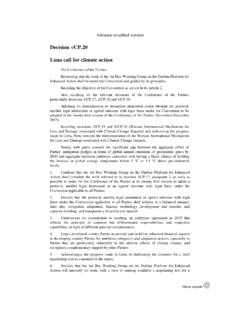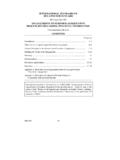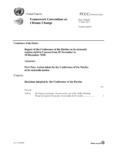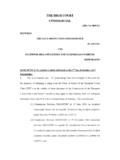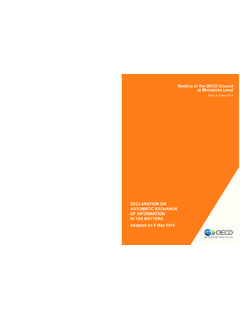Transcription of Agreed Syllabus for Religious Education 2015–2020
1 Herefordshire Agreed Syllabus for Religious Education 2015 2020. 0. Written by Stephen Pett, Kate Christopher, Lat Blaylock, Fiona Moss, Julia Diamond-Conway Images, including cover images, courtesy of NATRE/Spirited Arts NATRE. Published by RE Today Services, 1020 Bristol Road, Selly Oak, Birmingham B29 6LB. RE Today Services 2015. This Syllabus was written by RE Today Services and is licensed to Herefordshire SACRE for use in the schools in Herefordshire for 2015 2020. All rights reserved. Permission is granted to schools in Herefordshire to photocopy pages for classroom use only. No part of this publication may be reproduced, stored in a retrieval system, or transmitted in any form or by any means electronic, mechanical, recorded or otherwise, without the prior permission of the publisher. Printed in the UK by Stephen Austin and Sons Limited, Hertford SG13 7LU. Herefordshire Agreed Syllabus for RE, 2015 2020 RE Today Services 2015. 1. Contents page: Page Foreword 2.
2 Introduction 3. A What is RE for? A1 The purpose of RE 6. A2 The aim(s) of RE 7. A3 How to use this Agreed Syllabus : 12 steps 8. B What do we need to do? B1 Legal requirements 11. B2 What religions are to be taught? 13. B3 Time for Religious Education 14. C What do pupils learn in RE? C1 Religious Education key questions: an overview 16. C2 RE in EYFS. Programme of Study 19. EYFS Units of Study 23. C3 RE in KS1. Programme of Study and planning steps 31. KS1 Units of study 35. C4 RE in KS2. Programme of Study and planning steps 45. Lower KS2 Units of Study 49. Upper KS2 Units of Study 59. C5 RE in KS3. Programme of Study and planning steps 69. KS3 Units of Study 73. C6 RE in KS4 and 5: 14 19 Statutory Requirements 87. C7 RE in special schools 89. D How can we assess pupils' progress? D1 Assessment, achievement and attainment 94. D2 A progression overview for 5-14s: outcomes 96. D3 A model for assessment 97. E Guidance: E1 How RE promotes spiritual, moral, social 102.
3 And cultural development E2 RE and British Values 105. E3 Developing knowledge, skills and attitudes in RE 106. E4 Models of curriculum provision 110. Herefordshire Agreed Syllabus for RE, 2015 2020 RE Today Services 2015. 2. Foreword The members of SACRE are pleased to present this updated Herefordshire Agreed Syllabus for RE, that has been approved for implementation in schools from September 2015. In the light of the significant changes in Education policy and practice since 2011, the Agreed Syllabus Conference decided that RE in the county would best be served by amending the 2011 Syllabus for 2015 rather than delaying until 2016. However, despite these national changes we have sought to retain the heart of the 2011 Syllabus whilst increasing a focus on pupils' understanding of religions and beliefs, and updating assessment processes. We hope that you will find this element of continuity helpful for consolidating and enhancing the quality of Religious Education provision in Herefordshire schools.
4 The 2015 Syllabus retains the flexible approach that allows schools more freedom to develop units of RE and the RE curriculum to suit the context of their own school, as well as the step by step planning process to help teachers plan good quality schemes and lessons and to include more creative teaching and learning approaches. On behalf of SACRE, we are grateful to RE Today Services for developing this Syllabus , led by Stephen Pett, Herefordshire SACRE's RE consultant. He has brought his expertise and enthusiasm to drafting and redrafting documents, explaining proposed changes, leading all discussions and responding to feedback. The new Agreed Syllabus will bring us into line with our neighbours in Worcestershire. I hope that we will co-operate with Worcestershire and, indeed, Gloucestershire, even more in the future. We in SACRE trust that you will use this 2015 Herefordshire Agreed Syllabus for RE to meet the changing needs of our children and young people so that they grow into well informed and tolerant adults who respect the faiths and beliefs of others in the local, UK and world communities.
5 Councillor John Stone Chair of Herefordshire Standing Advisory Council on Religious Education (SACRE). Herefordshire Agreed Syllabus for RE, 2015 2020 RE Today Services 2015. 3. Introduction This Agreed Syllabus for Religious Education (RE) has been created for Herefordshire SACRE and approved by Herefordshire County Council. It provides a Syllabus for Religious Education for Herefordshire schools. Since 1944, all schools have been required to teach RE to all pupils on roll (with the exception that parents have the right to withdraw their children from the subject). Religious Education remains part of the basic curriculum for all pupils. The Syllabus explains the value and purposes of RE for all pupils, and specifies for teachers what shall be taught in each age group. It provides a coherent framework for setting high standards of learning in RE, and enabling pupils to reach their potential in the subject. It parallels the National Curriculum for community schools, but is also recommended for Church schools, academies and free schools.
6 The new Syllabus offers continuity with the 2011-2016 Syllabus in that it: outlines the legal requirements for RE. refines the principal aim for RE, clarifying the purpose of the subject outlines the breadth of study, indicating which religions should be studied and when offers key questions at the heart of the Syllabus , built around the strands Believing, Expressing, Living', found in the 2011 Syllabus offers schools the flexibility to devise their own key questions and design their own units develops exemplar learning outcomes for all key questions, linked to assessment outcomes offers an outline of knowledge/content as a guide to teachers re-states the 2011 planning process to support teachers. As well as the significant continuity, this Syllabus offers a development of RE from the previous Syllabus in that it: integrates learning about religion' and learning from religion' into the three aims ( ). develops some unit questions that enable a systematic study of religion, alongside thematic study, to enable pupils to gain a coherent understanding of religion offers more detailed suggested content, to support teachers with subject knowledge removes of levels of assessment, in line with the rest of the curriculum offers progressive learning outcomes, clarifying what pupils should know, understand and be able to do by the end of a unit, in order to enable pupils to meet end of key stage outcomes offers a flexible model of assessment builds on the most recent national guidance on RE, the RE Council's 2013 Curriculum Framework for Religious Education in England.
7 The Syllabus is for implementation from Autumn 2015. Acknowledgements Thanks to members of Herefordshire SACRE and Herefordshire teachers who were active in the development of this Agreed Syllabus . Herefordshire Agreed Syllabus for RE, 2015 2020 RE Today Services 2015. 4. Herefordshire Agreed Syllabus for RE, 2015 2020 RE Today Services 2015. 5. A. What is RE for? Herefordshire Agreed Syllabus for RE, 2015 2020 RE Today Services 2015. 6. A1 The purpose of RE. Religious Education contributes dynamically to children and young people's Education in schools by provoking challenging questions about meaning and purpose in life, beliefs about God, ultimate reality, issues of right and wrong and what it means to be human. In RE they learn about and from religions and worldviews in local, national and global contexts, to discover, explore and consider different answers to these questions. They learn to weigh up the value of wisdom from different sources, to develop and express their insights in response, and to agree or disagree respectfully.
8 Teaching therefore should equip pupils with systematic knowledge and understanding of a range of religions and worldviews, enabling them to develop their ideas, values and identities. It should develop in pupils an aptitude for dialogue so that they can participate positively in our society, with its diverse religions and worldviews. Pupils should gain and deploy the skills needed to understand, interpret and evaluate texts, sources of wisdom and authority and other evidence. They should learn to articulate clearly and coherently their personal beliefs, ideas, values and experiences while respecting the right of others to differ. The purpose of RE is captured in the principal aim, which is intended to be a short-hand version for day-to- day use. Teachers should use it when planning RE, whether long-term or short-term. It should be considered as a doorway into the wider purpose articulated above. Principal aim The principal aim of RE is to engage pupils in systematic enquiry into significant human questions which religion and worldviews address, so that they can develop the understanding and skills needed to appreciate and appraise varied responses to these questions, as well as develop responses of their own.
9 Schools might wish to devise a pupil-friendly version of this for themselves. Discussing this, using the full purpose and the principal aim, would be helpful for teachers in clarifying what RE is for in their school and classroom. For example: RE explores big questions about life, to find out what people believe and what difference this makes to how they live, so that pupils can make sense of religion, reflecting on their own ideas and ways of living.'. Herefordshire Agreed Syllabus for RE, 2015 2020 RE Today Services 2015. 7. A2 The aim(s) of RE. The threefold aim of RE elaborates the principal aim. The curriculum for RE aims to ensure that all pupils: 1. Know about and understand a range of religions and worldviews1, so that they can: describe, explain and analyse beliefs and practices, recognising the diversity which exists within and between communities and amongst individuals identify, investigate and respond to questions posed, and responses offered by some of the sources of wisdom2 found in religions and worldviews appreciate and appraise the nature, significance and impact of different ways of life and ways of expressing meaning.
10 2. Express ideas and insights about the nature, significance and impact of religions and worldviews, so that they can: explain reasonably their ideas about how beliefs, practices and forms of expression influence individuals and communities express with increasing discernment their personal reflections and critical responses to questions and teachings about identity, diversity, meaning and value, including ethical issues appreciate and appraise varied dimensions of 3. Gain and deploy the skills needed to engage seriously with religions and worldviews, so that they can: find out about and investigate key concepts and questions of belonging, meaning, purpose and truth, responding creatively enquire into what enables different individuals and communities to live together respectfully for the wellbeing of all articulate beliefs, values and commitments clearly in order to explain why they may be important in their own and other people's lives. Throughout schooling, teachers should consider how their teaching contributes towards the principal aim of RE in the local area, and how they help pupils to achieve the threefold aim.

